India Mission Trip, November 5-20, 2016 – Part 2
“I Have Decided to Follow Jesus”
In the last newsletter, I told about my recent trip to India, November 5-20. I, along with five other Americans, had been invited by EMU missionary, Billy J., to participate in the first annual Good News 360 Conference, held at the Ashirwad Global Learning Centre, a beautiful 3-acre campus located on the outskirts of Hyderabad, India’s fourth largest city. This three-day conference had been a great success, with God blessing those attending the conference. There were 570 people in attendance who heard messages on the themes of Preaching, Prayer, Equipping, and Servant Leadership. One of the joys of the conference was listening to the nationals sing with such passion and emotion. I asked if they knew any English songs. One song that they knew well was, “I Have Decided to Follow Jesus,” which they sang for us.
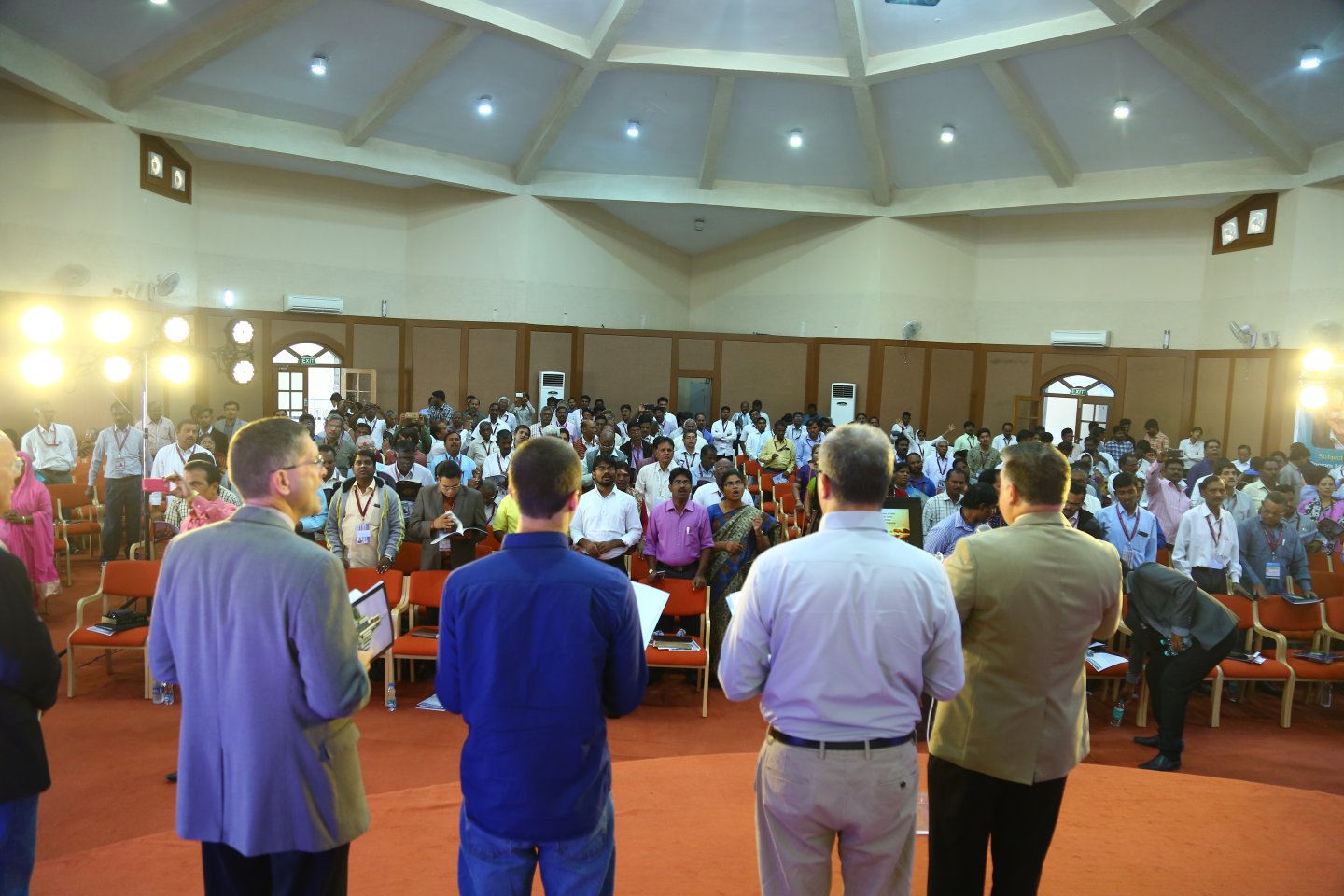
The Americans leading singing, “I Have Decided to Follow Jesus.”
The story behind this uniquely Indian hymn is not so much a tale of conversion as it is a tale of total commitment. It took place in Northeastern India, in the region of Assam. In the 1850’s a great revival had taken place in Wales. As a result, missionaries were sent out all over the world, with many focusing on Northern India. They were joined by missionaries from the United States, England, and Australia. A missionary movement began which was primarily led by Indian nationals themselves. The area of Northern India was a particularly rough area that was entrenched in Hinduism and the caste system and was the home of tribes of violent headhunters. In the late 1800’s, a missionary who had labored for many years facing difficult persecution finally witnessed his first converts come to know Christ. The townspeople were angry at the professed faith and baptism of the father, mother, and two children who had come to know Jesus Christ. The leaders of the village determined to make an example out of the father. He was arrested and shoved into the public square where an angry mob had gathered. He was ordered to renounce his faith in Christ or his wife and children would be killed. What could he say? The only thing that came to his mind was the words to a song that he had composed when he first had been saved. He sang, “I have decided to follow Jesus, no turning back, no turning back.” The man watched as his children were shot with arrows. He was given another chance. This time, the arrows were pointed at his wife. He continued to sing, “Though none go with me, still I will follow, no turning back, no turning back.” His wife also was executed with arrows. The arrows were then turned upon the man. He was given one more chance to turn from Christ. Instead, he sang, “The cross before me, the world behind me, no turning back, no turning back.” Along with his family, he was martyred for his faith. The story does not end there because the events of that day had allowed a gospel seed to be planted in the heart of the village chief. Over time, that seed grew. Eventually, he too was born again and the gospel began to flourish, not only in that town but all throughout the region of Assam. If you look in your hymnal, you will notice that the tune to the song, “I Have Decided to Follow Jesus,” is called Assam. It is a song about following Jesus, even in the most difficult of circumstances.
Before I left for India, I tried to understand as much as I could about the history, the religion, and culture of this dark country. India, with 1.32 billion people is second in world population, behind China which has 1.38 billion. India is projected to have the largest population in the world within the next fifteen years. Though the caste system was made illegal over sixty years ago, discrimination based on social standing is still very common. Over 800 million people currently live in poverty. 75% of the population currently live on less than $2.50 per day. Approximately one-fourth of all Indians cannot read or write.
According to Operation World, India, by far is the most unreached country in the world. One-third of the world’s unreached people groups are from one country, India. 400 million people in India have never heard the name Jesus. Constitutionally, there are 22 official languages in India, but there are over 1,600 other languages with no Scriptures.
India is a very religious country. It is the birthplace of four of the world’s major religions: Hinduism (the world’s oldest religion not associated with the Bible), Buddhism, Jainism, and Sikhism. 80% of the country identifies as Hindu. The word, “Hindu,” comes from the Persians who referred to the geographical location of the Indus as “Sindhu.” The word simply referred to a region, not a religion. Later on, the Greeks would call the Sindhu River, the Indus River. Thus, the name, India also came into existence. I discovered that there is a mountain of material on Hinduism, but it still is difficult to define. It does not have a founder. It is not a creedal religion like Islam or Christianity. It simply evolved over a period of nearly 5,000 years. It is a conglomeration of all of the cultural movements of India and all of the religions. Some say that adherents to Hinduism worship as many as 330 million gods.
There are several forms of Hinduism.
(1) Orthodox Hinduism is in the minority, but it still represents a powerful segment of the population.
(2) Another form is Dalit Hinduism. The word, “Dalit,” means broken and refers to the people known as the “untouchables,” the outcasts are those without a caste. They are animistic in their approach to religion.
(3) Tribal Hinduism is known by different names, but is commonly identified as “animism,” (from the Latin anima, meaning breath, life, spirit), which is the belief that everything, including animals, plants, rivers, mountains, stars, etc., has a soul and therefore should be worshipped because of their power to help or hurt.
(4) Most people in India would be followers of what is called Popular Hinduism. This is a mixture of orthodox and tribal faiths.
(5) The final classification is known as Militant Hinduism. This provides the foundation for Indian nationalism. To the Militant Hindu, India is Hinduism and Hinduism is India. The government of India is controlled by the Bharatiya Janata Party and led by Prime Minister Narendra Modi. Under their leadership, Militant (or radical) Hinduism has continued to grow, with minorities and non-Hindus facing persecution. The government often turns a blind-eye to this persecution.
Following the conference, three of the other Americans traveled back to the States, while three of us along with Billy J. spent the evening enjoying dinner and visiting the Muslim district of Hyderabad. In India, Islam is the religion of 14% of the population, but in Hyderabad 48% are Muslim. Around dusk, we stood in the bustling town square and heard the Muslim call to prayer echoing through the twilight from three different mosques.

Touring Hyderabad – Tombs, Fort, Auto-Rickshaw
The next morning, before the other Americans made their way back to the States, we visited the Qutb Shahi Tombs, 108 acres containing 72 monuments, some dating back to the 1500’s. The park contains the tombs and mosques, Persian looking buildings, that were built by the Sultans who ruled this part of India from 1518-1687. We then visited the Golkonda Fort, originally built in the 1100’s on a granite hill that stands 480 feet high and is surrounded by massive battlements. The fort served as the capital of the Qutb Shahi dynasty which was known for its wealth due to the diamond mines in the area. These mines have produced many of the world’s most famous gems, including the Kohi-i-Noor (the diamond that is in the center of the United Kingdom’s Queen Mother’s crown), and the Hope Diamond (45 carats, owned by the Smithsonian). After an adventurous and crowded ride on an auto-rickshaw, we enjoyed a delicious Lebanese meal and then I said good-bye to the other Americans as they were heading back to the States. I would remain in India for another week.
That evening I visited the main campus of the Good News Bible Colleges and Seminaries. Billy J. works with his father Dr. G. Jaya Sekhar, who in 1999 began the Bible college with 60 students. In the past seventeen years, they have established 46 Bible colleges throughout all of India. Billy’s ministry is called “One Fair Chance.” His goal is to see all 1.3 billion Indians have at least one chance at hearing the gospel. His focus is on training nationals to reach nationals, with a motto of “Each one, teach one, reach ten.” It was a joy to fellowship with the students and share the word of God.
On Sunday, I preached at the Hayathnagar Baptist Church. After removing our shoes and entering the auditorium, I was welcomed with the loud and passionate singing of the congregation as they began their worship. It was a joy to partake of the Lord’s Supper with these brothers and sisters. I then preached on Mark 1:35-39, where after an extremely busy day, our Lord rises early for the purpose of prayer and communion with the Father. Following the service, we enjoyed lunch with three of the pastors.
On Monday, Billy, his dad, their driver, and I began our journey south to visit and minister in several of the Bible colleges. While traveling the 205 miles to the city of Ongole, we saw the effects of the government’s most recent attempts at curtailing counterfeiting and tax evasion. On November 5, the announcement was made that all 500 ($7.60) and 1,000 Rupee currency notes had no cash value. This decision has greatly affected the poor and the middle class. Every time we passed a bank, we saw lines of people down the block trying to get their money. As a result, land value has decreased by 50%. This unannounced move has impacted every financial sector and naturally has had an adverse effect on private educational institutions such as the Bible colleges.
The all-day drive to Ongole was made more enjoyable thanks to the Dramamine I had brought with me. While Billy and I munched on pistachios and talked about the ministry I saw a beautiful side of India. We traveled through rolling hills dotted with cattle and water buffalo. We crossed some large rivers. In our journey, we passed hundreds of Hindu temples. In the South (USA), we talk about a Baptist church on every street corner. In India, Billy said there are two Hindu temples per street. We traveled through small mountains and rocky terrain, which along with the bright flowering trees reminded me of my recent trip to Phoenix.
Somewhere along the way, I had unsurprisingly picked up some kind of germ that gave me a cough that I would not shake until I returned to the States. We arrived in Ongole and met Brother Anil Kumar, the pastor and coordinator of GNBCS in Ongole. We stayed at his house and were shown wonderful hospitality. They brought me an Indian version of Nyquil and I rested for a while before we had our service for the night. When I entered the room, I was greeted by a large poster in the back of the room that read, “Heartily Welcome to Pastor Jeff Davis, USA.” The banner had a huge picture of my face that one of the students had taken of me preaching at the conference in Hyderabad a few days earlier. We had over one hundred people packed into a room that looked like it would hold thirty. Every one of my interpreters did an amazing job and the Lord used the preaching of His Word to challenge and encourage these believers. After each evening service throughout the week, I would enjoy a meal with the Pastor and his family before heading back to the hotel.
The next day, I learned a lot about Baptist history in Southern India. Billy has a tremendous heritage on both sides of his family. His great-grandfather was one of the founders of the Baptist church in Ongole. We visited the Jewett Memorial Prayer Hill and Jewett Memorial Baptist Church where approximately 6,000 people worship each Sunday. Missionary efforts in that area date back to 1840, with the ministries of American Baptist missionaries. The first believer was baptized in 1841 and a church began in 1844. It was a difficult mission field which yielded very little fruit. In 1862, Lyman Jewett was told that the American Baptist Missionary Union was going to close the Lone Star Mission in Ongole. Jewett replied, “You can give up the Telugu mission, but I will never abandon the Telugus. I will go back to India and die there.” One of the leaders replied, “Well, brother, if you return to die in India, we must send somebody to give you a Christian burial.” Against the advice of his mission board, Jewett returned along with John Clough. We visited the hill where these missionaries had prayed. In 1878, a movement of the Spirit of God like that at Pentecost resulted in John Clough baptizing 2,222 in one day and he and his assistants baptizing nearly 9,000 members of the Madiga (Dalit) community in and around Ongole in a six-week period.
That evening I had the privilege of recording a 30-minute message on John 3, “You Must Be Born Again,” for a local TV station called Satya Vakam which broadcasts to 300,000 people. I again preached for the GNBCS group with a larger group attending. At the end of my message, a 12-year-old boy wanted to share a testimony of how God is calling him into the ministry of sharing the gospel with his people. I was able to spend some time that evening following our meal encouraging the young man as his family gathered around and took pictures of us.
The next morning, we set out on our five-hour drive to Tirupati. My back and stomach muscles were aching from all of the coughing, but God was giving grace. Every time I preached, the Lord was leading me to a different text that ended up being what the leaders needed to support their efforts in their schools. We stopped near the coast of the Bay of Bengal and visited the Ramapadnam Baptist Theological Seminary. The school was established in the 19th Century with a motto, “Preach Christ Crucified.” Sadly, the school closed in 2011. We drove about a mile to the coast and looked out over the water. As I looked at the nearby lighthouse, I could not help but think how this country needs the light of the gospel of Jesus Christ. We drove through the third-world village nearby and saw another little village dotted with Hindu temples, cows wandering the streets, women carrying water jars on their heads, and ditches that served as sewers.
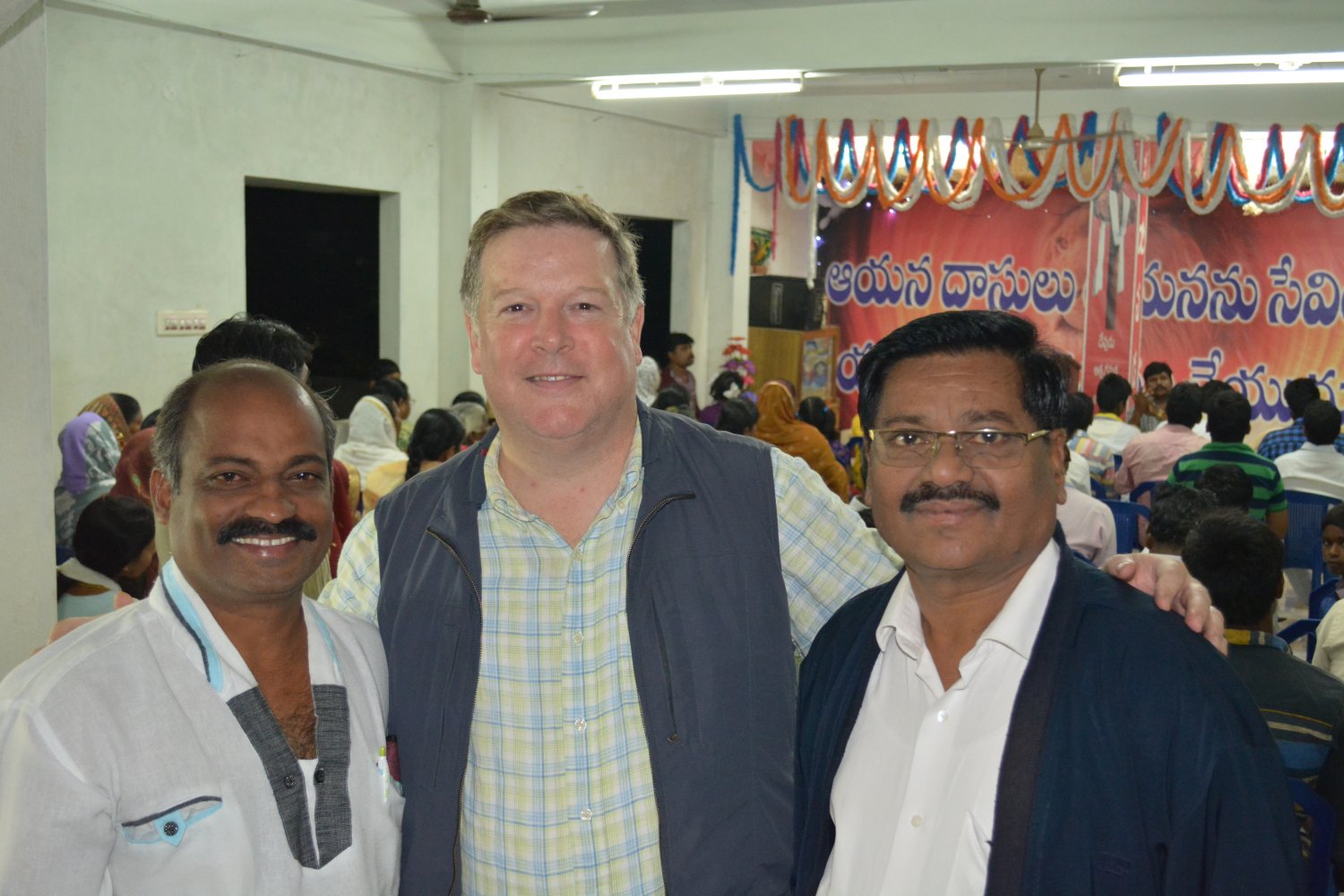 We drove another hour or so towards our destination but stopped for lunch at a rest stop. It was a dreary, rainy day when we started, but now the sun was shining in full force and we were feeling the tropical heat. We parked on the Southwest side of the expressway and had to cross to get to the restaurant. We met up with a couple of men, one who was Asha Meenan, a GNBCS coordinator that I recognized from the conference the week before. After lunch, we made our way to Tirupati, a city of approximately 460,000 people. It is known as the “Spiritual Capital” of the State of Andhra Pradesh, because of the many Hindu temples, particularly the Tirumala Venkateswara Temple. After checking into our hotel, we left for the New Cornerstone Prayer House and met with pastor and GNBCS coordinator Rudhra Paul. Like the nights before, the room was packed, the music was loud, and the people were very sincere in the worship. It was a joy to preach on 2 Timothy 1 and encourage these believers to not be ashamed of Christ and to share in suffering for Him. I told them I enjoyed their singing and that I was going to sing for them. I sang “How Great Thou Art.” After the meal that night with the pastor and his family, we stood outside the meeting house. It was dark as we stood on the hill, but we could see the outline of a nearby mountain. I mentioned that it looked like there could be tigers up there. The pastor told us that tigers have been known to come down to the village out of the mountain. They also have had pythons that have eaten the dogs in the area.
We drove another hour or so towards our destination but stopped for lunch at a rest stop. It was a dreary, rainy day when we started, but now the sun was shining in full force and we were feeling the tropical heat. We parked on the Southwest side of the expressway and had to cross to get to the restaurant. We met up with a couple of men, one who was Asha Meenan, a GNBCS coordinator that I recognized from the conference the week before. After lunch, we made our way to Tirupati, a city of approximately 460,000 people. It is known as the “Spiritual Capital” of the State of Andhra Pradesh, because of the many Hindu temples, particularly the Tirumala Venkateswara Temple. After checking into our hotel, we left for the New Cornerstone Prayer House and met with pastor and GNBCS coordinator Rudhra Paul. Like the nights before, the room was packed, the music was loud, and the people were very sincere in the worship. It was a joy to preach on 2 Timothy 1 and encourage these believers to not be ashamed of Christ and to share in suffering for Him. I told them I enjoyed their singing and that I was going to sing for them. I sang “How Great Thou Art.” After the meal that night with the pastor and his family, we stood outside the meeting house. It was dark as we stood on the hill, but we could see the outline of a nearby mountain. I mentioned that it looked like there could be tigers up there. The pastor told us that tigers have been known to come down to the village out of the mountain. They also have had pythons that have eaten the dogs in the area.
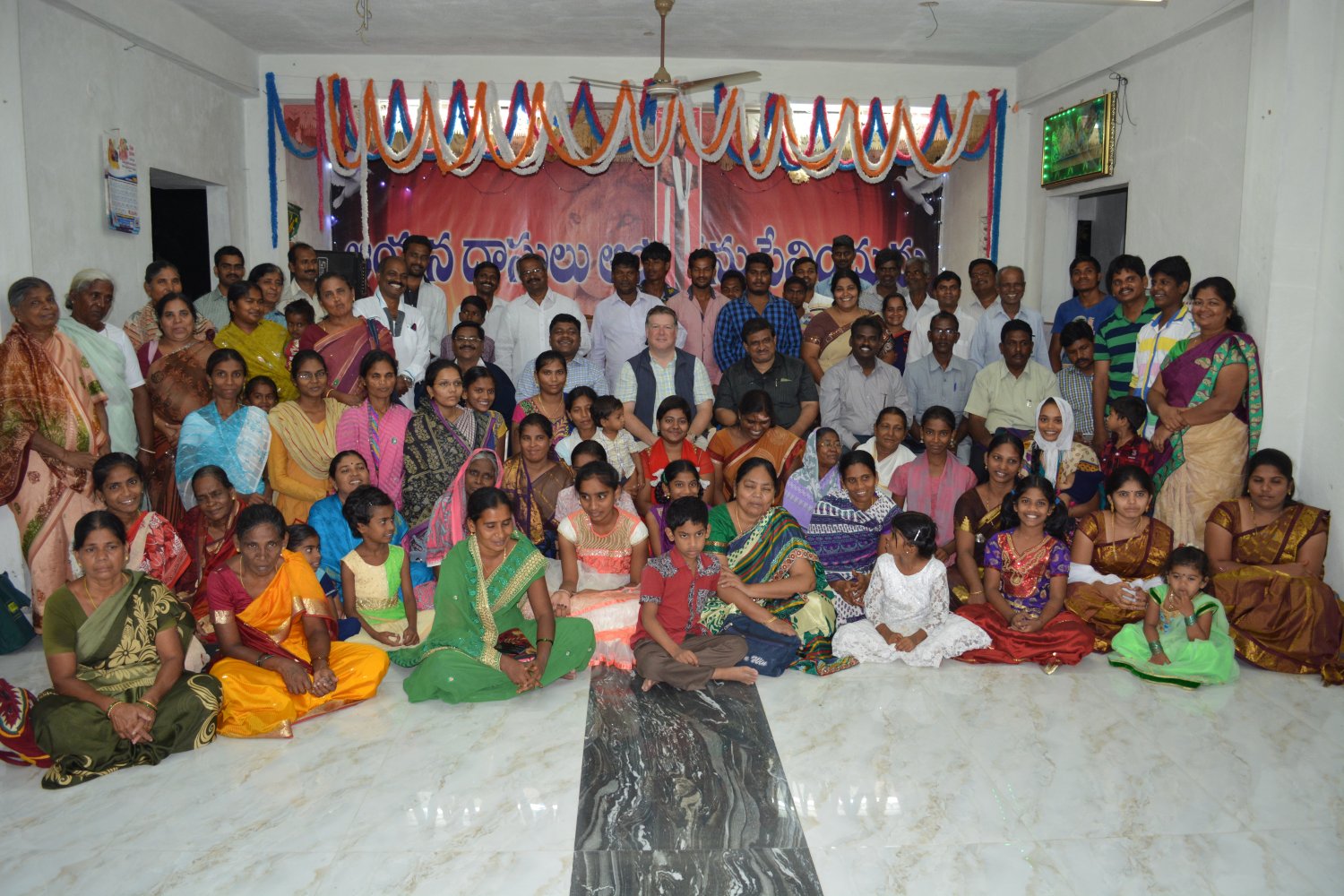
New Cornerstone Prayer House
The next day we visited the Tirumala Venkateswara Temple, constructed in 300 AD. I had not heard of it, but it is known as the richest temple in the world. It is also the most-visited holy site in the world with a daily 50,000-100,000 pilgrims who visit. During special occasions and festivals, as many as 500,000 will attend in a day. It is known as the Temple of Seven Hills.
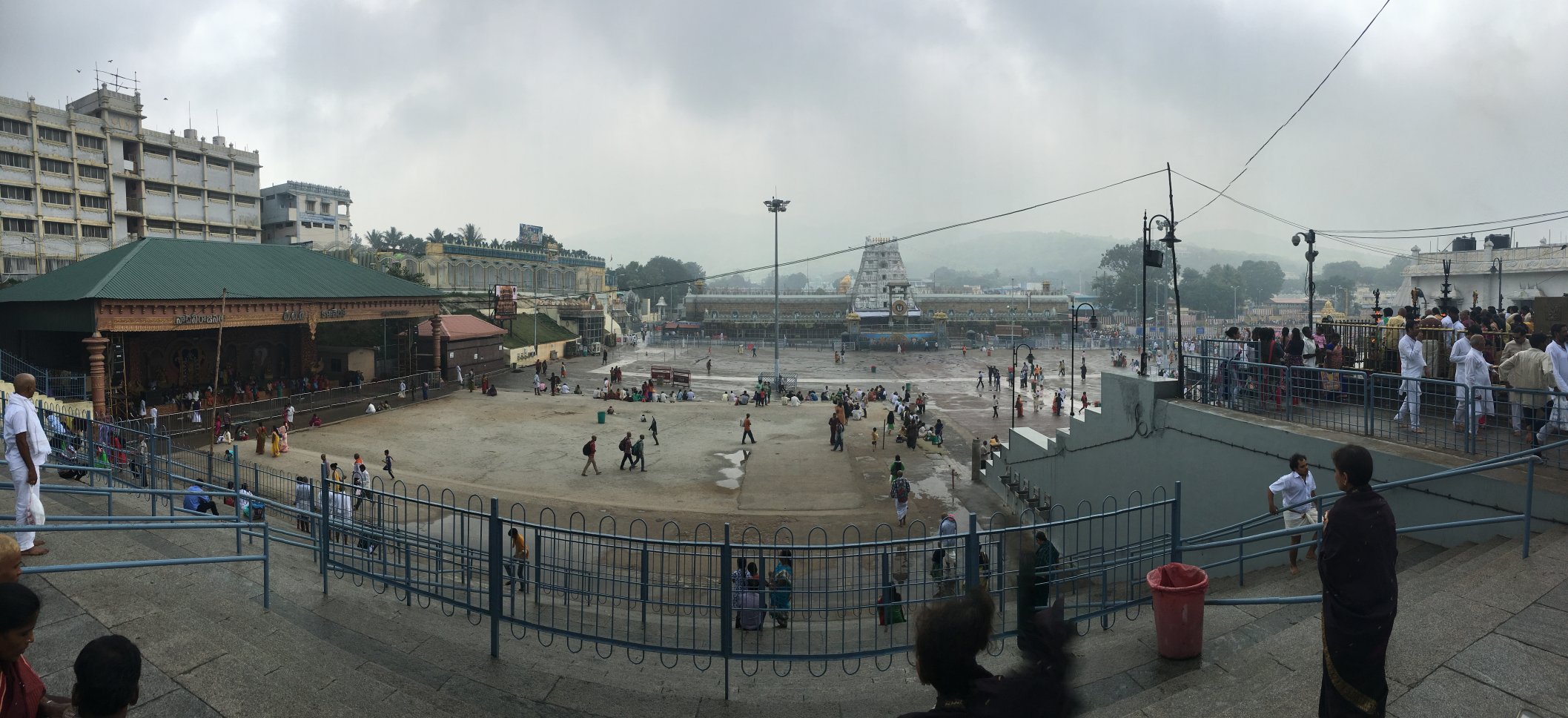
Tirumala Venkateswara Temple
That evening we drove about an hour away to Puttar where for the first time I repeated a message that I had preached in India. The GNBCS coordinator John Milton wanted me to preach the message that I had begun the conference with the week before on the subject of servant leadership. Again, the house was packed and we enjoyed a sweet time of fellowship in a very hot room. Afterward, I enjoyed a meal with the pastor and his family. A large group hung around and asked questions about the message earlier. That evening, I was feeling the effects of my cold and two weeks of preaching.
On Friday morning, we met one of the pastors who lives in the area for breakfast with his family at his home. He then wanted to show us his church and school. He was going to leave while we went to the New Corner Stone Prayer Temple but felt led of the Lord to stay. I preached that morning to the smallest group, but God led me to Acts 17 and Paul’s ministry at Mars Hill. Athens was a city covered in idols and God used the parallels of that text to challenge the heart of the two preachers present and the people who had gathered on a Friday morning. Before we left, there were tears all around. I was ready to get home and see my family, but I didn’t want to leave. God had shown me a group of people that truly were willing to follow Jesus, whatever the cost.
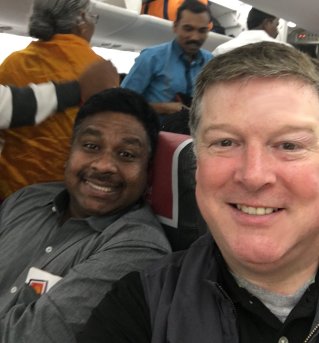 Billy and I took a flight back to Hyderabad that cost us only $59 each. We saw it as good stewardship, taking a one-hour flight versus a ten-hour drive. We were able to tie up loose ends before I left the next day to fly back to the States. Please believe me that there is no way I can describe for you in these two articles everything that God taught me during my two weeks in India. If nothing else, remember with me that God’s light is shining in the darkest of corners of our world. Believers have determined with that unknown author from the region of Assam, “I have decided to follow Jesus, no turning back, no turning back.”
Billy and I took a flight back to Hyderabad that cost us only $59 each. We saw it as good stewardship, taking a one-hour flight versus a ten-hour drive. We were able to tie up loose ends before I left the next day to fly back to the States. Please believe me that there is no way I can describe for you in these two articles everything that God taught me during my two weeks in India. If nothing else, remember with me that God’s light is shining in the darkest of corners of our world. Believers have determined with that unknown author from the region of Assam, “I have decided to follow Jesus, no turning back, no turning back.”